What Are Whales Telling Us About the Earth? |
by Dr. Reese Halter - Conservation biologist
30 Novemder, 2010 - http://www.drreese.com/
Last year, Iceland and Norway killed 688 whales while Japan, under the guise of "scientific research," slaughtered 1,000 whales. In the 20th century humans decimated the whale populations around the globe by 1.5 million animals.
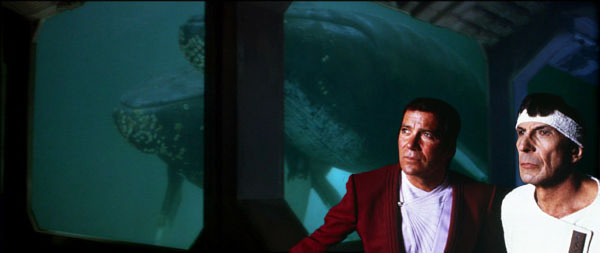 Voyage Home - Whales must be protected |
Interestingly, the message from Star Trek IV -- The Voyage Home -- that in order to save the Earth whales must be protected -- seems more valid now than ever before.
Reports from the last couple months clearly showed that the whales are helping researchers determine atmospheric science, Arctic oceanography, the extent of global warming, marine food web nutrition and record breaking migration patterns. Incidentally, all of these fascinating discoveries are taking place on frugal scientific budgets.
Workers from the Zoological Society of London and Queen Mary University recently examined 156 blue, fin and sperm whales swimming in the Gulf of California -- a United Nations World Heritage site. The whales are showing the scientists that the hole in the ozone layer is getting worse, allowing lethal UV radiation to penetrate Earth's protective ozone shield and cause skin cancers and cataracts.
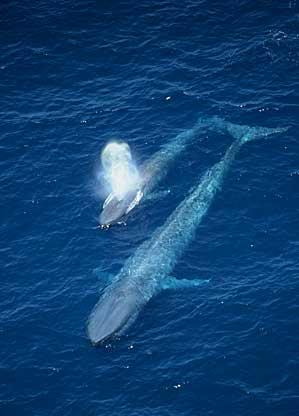 Blue whale and calf |
From high-resolution photographs and studying whale skin samples, they have concluded that the whales are becoming sunburnt during the time they are spending at the surface. Blue whales, who have fairer skin than most whales, suffered significantly more than the much darker fin whales. And sperm whales, which spend a considerable amount of time on the surface, breathing and socializing for hours at a time were also vulnerable to sun damage.
The study found that the lesions and sunburnt cells on blue whales had worsened considerably from an earlier survey in 2007.
Since the hole in the Antarctic ozone layer was first discovered in the 1970s, ozone levels have shrunk by up to 70 percent in the worst seasons. Although the CFCs, which damage the ozone level, were banned in 1987 ozone levels are not expected to recover until about 2050.
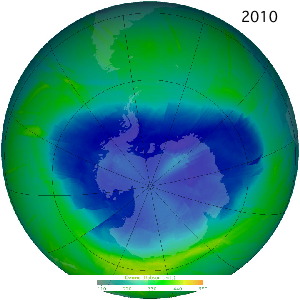 Antarctic Ozone Hole - Sept. 2010 |
In fact, UV radiation is expected to increase by 4 percent in the tropics and 20 percent in the poles over the next few decades. At this point in time scientists are not clear whether various life-threatening cancers will develop on whales exposed to high levels of UV radiation.
One thing is for certain: people spending time outdoors must wear sunscreen and protective eye wear.
Researchers from Harvard University and the University of Vermont have found that humpback whales in the Gulf of Maine carry massive quantities of nitrogen from the deep sea where they feed to the surface and release it in their liquid-like feces. Essentially, humpbacks function as an "upward biological pump."
It turns out that humpbacks contribute more nitrogen to the Gulf of Maine than all the local rivers combined, an estimated 25,000 tons, annually.
In turn, these nutrients allow more phytoplankton to grow which increases the food supply at the base of the marine food web therefore promoting bigger fisheries and higher abundance where whales occur in greater densities.
Clearly, it is erroneous to claim, as the three whaling countries tout, that whales compete with their commercial fisheries; rather, they enhance them.
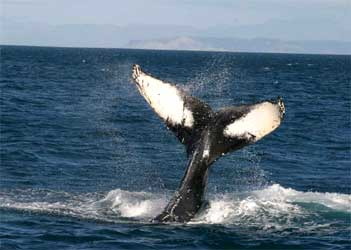 Humpback whale tail |
Last month, scientists from the College of the Atlantic in Maine browsing the photo-sharing site Flickr found identification markings on a humpback tail or fluke taken by a Norwegian tourist whale watching at the breeding grounds near Ile Sainte Marie off the east coast of Madagascar, Indian Ocean in 2001.
In 1999 that female was pictured in the breeding grounds off Abrolhos, an area of small volcanic islands along the southern Brazilian coast, Atlantic Ocean.
The female humpback whale swam at least 6,125 miles -- or nearly a quarter of the globe; it was the longest documented movement by a mammal ever recorded.
Until now, humpback migration patterns were believed to be North/South rather than East/West. Was she responding to a distant complex song, following prey, exploring new breeding habitats or was she simply wandering as whales are so perfectly engineered for? We have a lot to learn from our cetacean friends.
The iconic, spiraled tooth (or tusk) narwhals, permanent residences of the high Arctic possess brains to body sizes just slightly smaller than humans. These extraordinary beauties of a beast dive greater than one mile in pitch-dark icy Arctic water, relying upon echolocation or sonar to hunt, only during the winter, Greenland halibut. They spend up to three hours a day at least a half a mile from the surface exquisitely adapted to over 80 atmospheres of pressure.
Oceanographers from the University of Washington and Greenland's Institute of Natural Resources tagged 14 adult narwhals with sensors and determined that the temperature of the Arctic Ocean was almost 2 degrees Fahrenheit warmer than previously thought.
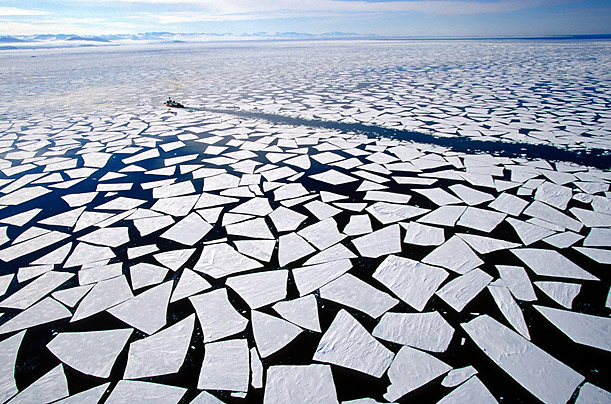 Ice shelves the size of small countries are crumbling away |
The Arctic is warming at an unprecedented rate. In the 1980s, the Arctic contained about 386,000 square miles of ice that was at least five years old. At the end of September 2010 only 22,000 square miles of such older, thicker ice remains. The Arctic has lost 97 percent of the thicker year-round ice that existed just three decades ago.
Not only are the whales helping us determine how quickly global warming is occurring. They're also helping to determine the extent of the hole in the ozone layer. In addition, since 40 percent of the ocean's phytoplankton is missing from warming ocean temperatures and ocean acidification (from absorbing rising levels of CO2), the whales are crucial in their role to fertilize the oceans and replenish phytoplankton -- the base of the entire marine food web.
In 2008, 13 million people from 119 countries paid $2.1 billion to see the whales. Around the globe, whale watching tourism is growing at 10 percent per annum. It's time now to end the whale hunt and grant amnesty to magnificent creatures that are helping us survive on our blue planet.
The Author: Dr. Reese Halter is a Science Communicator: Voice for Ecology, conservation biologist at Cal Lutheran University, public speaker and author of "The Incomparable Honeybee," Rocky Mountain Books. He can be reached through www.DrReese.com
Source: http://www.huffingtonpost.com/dr-reese-halter/what-are-whales-telling-u_b_789561.html
Copyright © 2010 TheHuffingtonPost.com Inc.